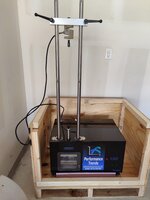Dave_W
Cones - not just for ice cream
So this seems as good a thread as any to bring up an idea I have about shock adjustment, particularly on the compression side. Say I've got a typical digressive damping curve, and the damping is good for the spring/bar/wheel rate, so adjustment is mainly for driver feel. Generally, I see shock dyno graphs of adjuster settings that look like this -

As I make the damping stiffer, both low- and high-speed are affected. Even if the adjuster is labeled only "low-speed." I think I've even seen this in shocks with separate high- and low-speed adjustment when only the low-speed only is changed. In my view, I'd call this cross-talk from low-speed adjuster to high-speed damping.
The issue I have with this is the case were you've got the high-speed compression set to blow off over curb hits the way you like, but you want more low-speed stiffness to give the car more "support" in transitions. You need to have a 3- or 4-way shock so you can stiffen the low-speed and then soften the high-speed to eliminate the increase from the crosstalk. And if you're doing this at the track, you're just guessing on how much to soften the high-speed to compensate.
What I'd like to see is a low-speed adjuster that does this -

The adjustment to low-speed has no affect on the high-speed. Set the blowoff once and forget it. Play around with "suppport" without worrying about crashing the curbs. I have no idea if some type of hydraulic valve can acheive this. Maybe this is what magneride is doing, though (among other things).
Then again, maybe I'm wrong about all this.

As I make the damping stiffer, both low- and high-speed are affected. Even if the adjuster is labeled only "low-speed." I think I've even seen this in shocks with separate high- and low-speed adjustment when only the low-speed only is changed. In my view, I'd call this cross-talk from low-speed adjuster to high-speed damping.
The issue I have with this is the case were you've got the high-speed compression set to blow off over curb hits the way you like, but you want more low-speed stiffness to give the car more "support" in transitions. You need to have a 3- or 4-way shock so you can stiffen the low-speed and then soften the high-speed to eliminate the increase from the crosstalk. And if you're doing this at the track, you're just guessing on how much to soften the high-speed to compensate.
What I'd like to see is a low-speed adjuster that does this -
The adjustment to low-speed has no affect on the high-speed. Set the blowoff once and forget it. Play around with "suppport" without worrying about crashing the curbs. I have no idea if some type of hydraulic valve can acheive this. Maybe this is what magneride is doing, though (among other things).
Then again, maybe I'm wrong about all this.















